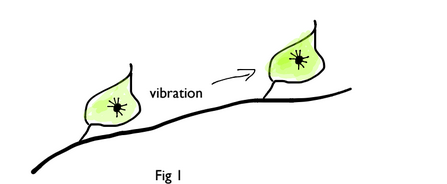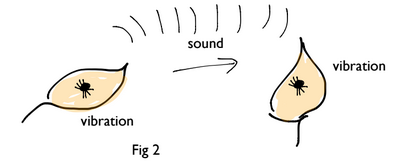Some kinds of spider can communicate with others of their species (for threat or courtship) by vibrations, as I've tried to sketch in Fig 1 below.

However they can't, as far as I know, hear sound that is carried through the air, in the way many land dwelling animals do.
But research suggests one spider does use sound indirectly, in a way that reminds me a bit of the "baked bean tin telephone'.
You may know this, but if not, the idea of this improvised communication device is you get two empty tin cans, punch a small hole through the base of each, and then use a string knotted at both ends to connect the cans. The cans are held so the string is tight and then one person holds their can to their mouth, the person at the other end holds their can to their ear. When the first person speaks quietly, the listener can hear them, even over some distance.
This works because sound at one end is converted into vibrations in the string and at the receiving end the tin can resonates, and the vibration becomes audible sound again.
The "purring wolf spider" reverses the baked bean tin trick. One spider stands on a leaf (I think it needs to be dead so it will rustle) and generates vibrations, and vibrating the dry leaf produces sound (which is audible to humans).
The sound causes nearby leaves to resonate in sympathy, and a spider standing on one will feel the vibrations, Fig 2.

Where does Prufrock come in? Well it seems the female spiders on their leaves are the most responsive to the sound and so it may be a courtship song.
Learn more here.
Comments
New comment
We have some ghost spiders (I don't know what they're really called, but they look like a grain of rice with fragile legs about 2" long) which vibrate their web when disturbed. It is quite odd and funny to see - the spider will become a blur as it vibrates so fast. I read somewhere that is a strategy to confuse birds. Well, it confused me when I first noticed it and I'm a bloke.
I suppose a spider's web—designed to be elastic so it doesn't break when a fly gets caught and struggles in it—must make a spiffy trampoline. (Trampoline (noun), cheap substitute for alcohol bought in DIY shops and drunk by vagrants. Viz.)
When they get round to analysing the DNA of spiders, I won't be the least bit surprised when it gets announced they are aliens. I've always suspected they are the degenerated remnants of a lost patrol that landed here looking for some way to repair their ship.
New comment
The consensus is that all life on Earth evolved from a singe primeval cell (but I don't see why we assume this, they could have been several or many).
Intriguingly some people have suggested that aliens could have evolved here on Earth. There might be independent lineages living all around but invisible to us. Maybe they occupy even more different metabolic niches than the very varied livings of bacteria in undersea volcanic vents, or organisms living kilometers down in basalt. Perhaps we haven't noticed them because they are so different, or perhaps because they never touch us. They could be silicon based, or aluminosilicate based, and since they are not pathogens orf baron-based life imple fo unnoticed.
PS the spell checker suggested that by 'aluminosilicate' I meant 'terminological'. So obviously aliens are indeed amongst us and have infected our spell checkers!
New comment
And they changed
'of carbon-based life forms they go unnoticed'
to
'orf baron-based life imple fo unnoticed'.
Damn those aliens.
New comment
That's OK.
My brain saw "and since they are not pathogens orf baron-based life imple fo unnoticed" and read it as "and since they are not pathogens or baryon-based life it's simple to go unnoticed".
This made me conclude you might be a lepton-based life form, since you think baryons are a bit obvious.
Perhaps chavs and Essex stereotype folk are the baryons of the human world: all noise and mass and all too easily spotted, whereas ballerinas and divas are the leptons.
I now visualise electrons as fickle eldritch creatures, flitting from atom to atom, never far from their own kind yet unable to bear to be near their own kind.
But I still don't trust spiders. Too many legs and all those eyes? They're up to something.